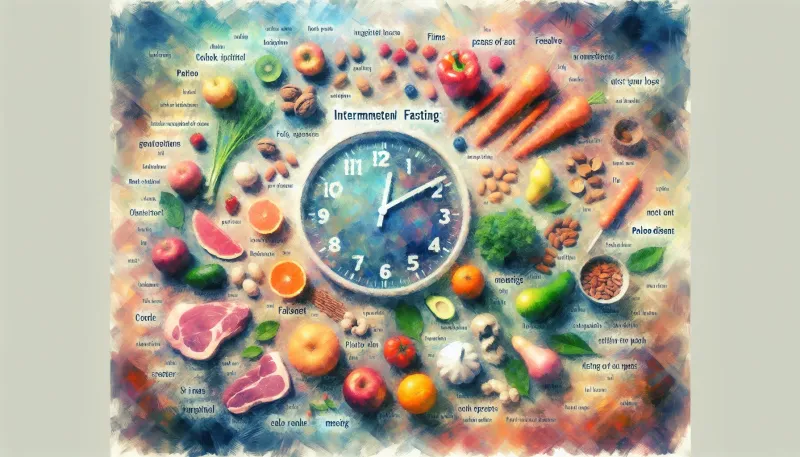Paleo Diet and Intermittent Fasting: The Ultimate Guide to Weight Loss and Better Health

Discover the ultimate guide to weight loss and better health through the Paleo diet and intermittent fasting. Learn effective strategies and benefits here.
The quest for weight loss and better health often leads to the exploration of various diet plans and fasting protocols. Two popular methods that have attracted significant attention are the Paleo diet and intermittent fasting. This guide delves into the principles, benefits, and implementation strategies of both approaches, offering a comprehensive roadmap to a healthier lifestyle.
Understanding the Paleo Diet
The Paleo diet, also known as the "Paleolithic diet" or "Caveman diet," aims to emulate the eating habits of our prehistoric ancestors. This diet emphasizes whole foods that were presumably consumed during the Paleolithic era, excluding processed foods, grains, legumes, and dairy.
Core Principles of the Paleo Diet
- Emphasis on whole, unprocessed foods
- High consumption of lean meats, fish, fruits, vegetables, nuts, and seeds
- Avoidance of grains, legumes, dairy, refined sugar, and processed oils
Benefits of the Paleo Diet
Adhering to the Paleo diet can lead to numerous health benefits, including:
- Weight Loss: The diet's focus on nutrient-dense foods and the exclusion of processed foods can foster weight loss.
- Reduced Inflammation: Many of the foods included in the Paleo diet have anti-inflammatory properties that can help reduce chronic inflammation.
- Improved Digestive Health: The elimination of grains and legumes, which can be hard to digest, often alleviates digestive issues.
- Enhanced Blood Sugar Control: By avoiding refined sugar and carbohydrates, the Paleo diet helps stabilize blood sugar levels.
What is Intermittent Fasting?
Intermittent fasting (IF) is an eating pattern that cycles between periods of eating and fasting. Unlike traditional dieting, which focuses on what to eat, intermittent fasting focuses on when to eat.
Popular Intermittent Fasting Methods
- 16/8 Method: Involves fasting for 16 hours and eating within an 8-hour window each day.
- 5:2 Diet: Consists of eating normally for five days a week and significantly reducing calorie intake (about 500-600 calories) on the other two days.
- Eat Stop Eat: Involves fasting for 24 hours once or twice a week.
Benefits of Intermittent Fasting
Intermittent fasting can offer a wide range of health benefits, including:
- Weight Loss: By reducing the eating window, intermittent fasting can lead to a caloric deficit, promoting weight loss.
- Improved Metabolic Health: Fasting can improve insulin sensitivity and reduce insulin levels, which can help protect against type 2 diabetes.
- Cellular Repair: Fasting triggers autophagy, a process where cells remove damaged components, leading to rejuvenation and repair.
- Enhanced Brain Function: Intermittent fasting may improve brain health by boosting the production of brain-derived neurotrophic factor (BDNF) and reducing oxidative stress.
Combining the Paleo Diet and Intermittent Fasting
Pairing the Paleo diet with intermittent fasting can amplify the benefits of both approaches. Here are some strategies for successfully combining these methods:
Start Gradually
If you're new to both the Paleo diet and intermittent fasting, it's advisable to start with one method before integrating the other. Gradually ease into the Paleo diet by slowly eliminating processed foods, grains, and dairy. Once accustomed, incorporate intermittent fasting into your routine.
Plan Your Meals
Successful integration requires careful meal planning. Ensure your meals within the eating window are nutrient-dense, focusing on lean proteins, healthy fats, and a variety of fruits and vegetables.
Stay Hydrated
During fasting periods, staying hydrated is crucial. Water, herbal teas, and black coffee (without added sugar or cream) can help mitigate hunger and keep you hydrated.
Listen to Your Body
Pay attention to how your body responds to the combined approach. If you experience persistent fatigue, dizziness, or other adverse effects, it may be necessary to adjust your eating and fasting windows or consult a healthcare professional.
Common Challenges and Solutions
While the Paleo diet and intermittent fasting offer numerous benefits, they may also present challenges. Here are some common issues and practical solutions:
Overcoming Hunger During Fasting
Hunger is a common challenge during fasting periods. To manage hunger, consider:
- Starting with shorter fasting windows and gradually increasing the duration
- Drinking plenty of water and herbal teas
- Ensuring your meals contain high amounts of protein and fiber, which promote satiety
Maintaining Social Eating Habits
Social gatherings can pose a challenge when following a strict diet. Here are some tips:
- Plan Ahead: Inform hosts or choose restaurants with Paleo-friendly options.
- Flexible Fasting: If adhering to your fasting window isn't possible, consider adjusting it occasionally to accommodate social events.
Ensuring Nutrient Intake
The restrictive nature of the Paleo diet may lead to nutrient deficiencies if not carefully managed:
- Diverse Food Choices: Include a variety of fruits, vegetables, and protein sources.
- Supplements: Consider supplements for nutrients that are hard to obtain through the diet, such as vitamin D or calcium.
Conclusion
The combination of the Paleo diet and intermittent fasting offers a powerful approach to achieving weight loss and better health. By focusing on whole, unprocessed foods and incorporating structured fasting periods, individuals can harness the synergistic benefits of both methods. However, it's essential to listen to your body, stay informed, and make adjustments as necessary to ensure long-term success. With proper planning and commitment, the journey to a healthier lifestyle through the Paleo diet and intermittent fasting can be both rewarding and sustainable.



























